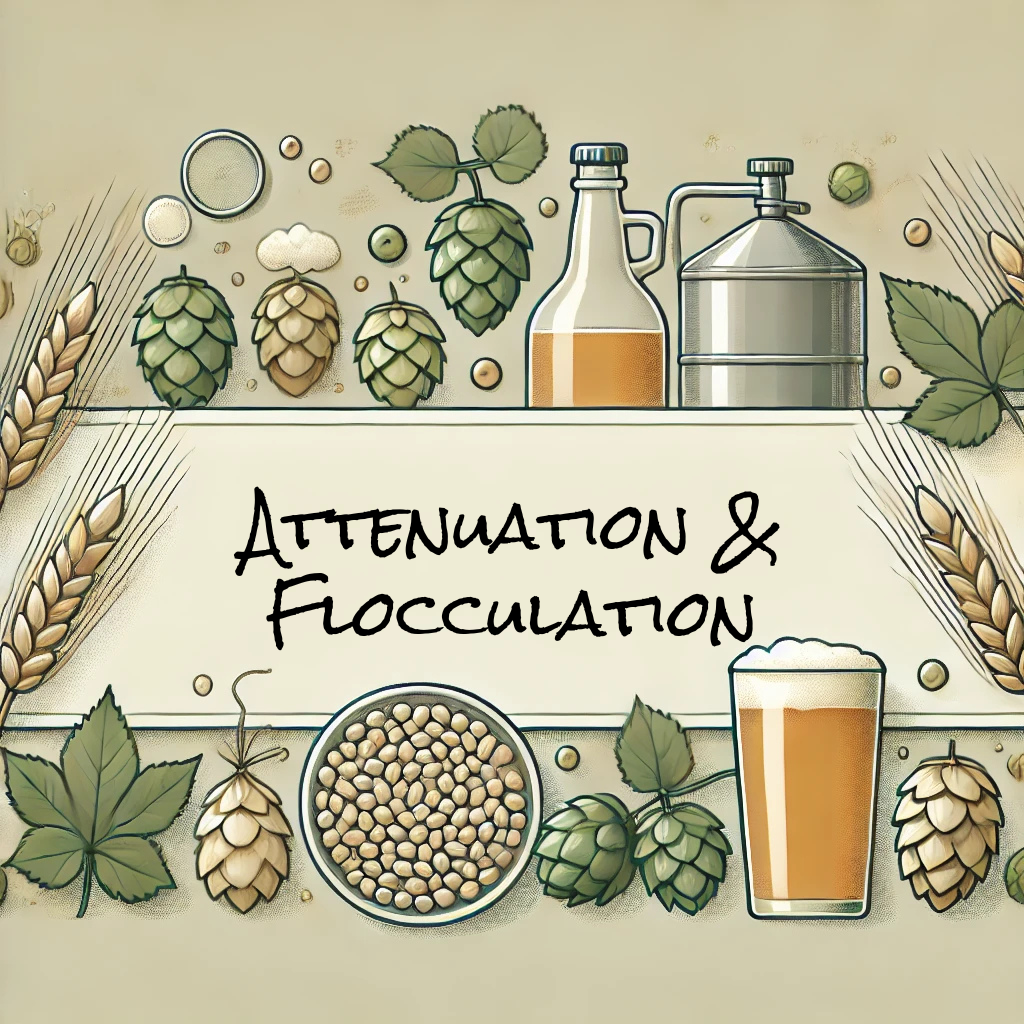
アテニュエーションとフロックレーションを理解する:醸造家にとって重要な指標
アテニュエーションとフロックレーションを理解する:醸造家にとって重要な指標
ビールの醸造では、酵母が麦汁を私たちが愛する飲み物に変える中心的な役割を果たします。酵母株を選ぶ際、多くの特徴が考慮されますが、ビールのスタイルと品質に直接影響を与える2つの指標が際立っています。それが、**アテニュエーション(発酵度) と フロックレーション(凝集性)**です。これらの指標を理解することは、理想的なビアスタイルを達成するために不可欠です。
アテニュエーションとは?
**アテニュエーション(発酵度)**は、発酵中に酵母がどれだけの糖を消費するかを測定する指標です。これはビールのボディ、甘さ、アルコール度数に直接影響します。アテニュエーションは通常、パーセンテージで表され、次のように分類されます:
低いアテニュエーション(65%以下): より多くの残糖が残り、甘くフルボディのビールになります。例:ミルクスタウトやスコティッシュエール。
中程度のアテニュエーション(66%~75%): 甘さとドライさのバランスが取れたビール。例:ペールエールやポーター。
高いアテニュエーション(76%以上): ドライなビールを生み出し、アルコール度数が高くなります。例:IPA、セゾン、ドライスタウト。
アテニュエーションの測定方法:
見かけのアテニュエーション(Apparent Attenuation): 初期比重(OG)と最終比重(FG)の差を使用して計算されます。非発酵性糖を考慮しないため、やや高めの値が出る場合があります。
実際のアテニュエーション(Real Attenuation): 非発酵性糖を考慮した、より正確な測定値。ただし、日常的な醸造ではあまり使用されません。
高いアテニュエーション
低いアテニュエーション
フロックレーションとは?
**フロックレーション(凝集性)**は、酵母細胞がどの程度まとまり、発酵後にビールから沈殿するかを指します。これにより、透明度、口当たり、濾過の容易さが影響を受けます。酵母株は通常、その凝集特性によって分類されます:
低いフロックレーション: 酵母が長く懸濁液中に残り、NEIPAや小麦ビールのようなヘイジースタイルに適しています。
中程度のフロックレーション: 透明度と風味のバランスが取れ、エールやバランスの取れたビールスタイルに適しています。
高いフロックレーション: 酵母が速やかに沈殿し、明るく透明なビールを生み出します。例:ラガーやイングリッシュエール。
風味と透明度への影響:
低いフロックレーション酵母は、口当たりを向上させ、より豊かな風味を加えることができます。
高いフロックレーション酵母は、一部の風味成分を取り除く場合がありますが、透明度と飲みやすさを向上させます。
低いフロックレーション
高いフロックレーション
アテニュエーションとフロックレーションの相互作用
アテニュエーションがビールの残糖分とアルコール度数を決定する一方で、フロックレーションは透明度と質感に影響を与えます。適切な酵母株を選択することは、これらの要因をバランスよく調整することを意味します。
IPAの場合: 高いアテニュエーションでドライさを確保し、低~中程度のフロックレーションで酵母を懸濁状態に保ち、ホップのアロマを引き立てます。
ラガーの場合: 高いアテニュエーションと高いフロックレーションが連携し、クリスプでクリーンな仕上がりと優れた透明度を実現します。
セゾンの場合: 高いアテニュエーションがドライでリフレッシングなビールを生み出し、低いフロックレーションが複雑さと口当たりを向上させます
醸造におけるエステルとフェノールの管理方法
-
酵母の選択:
エステルまたはフェノールの生成で知られる株を選択します。例:ヘフェヴァイツェン酵母はエステルが多く、ベルジャン酵母は両方を生成する可能性があります。
-
発酵温度:
高温は通常、エステルの生成を増加させます。フェノールの生成は酵母株に依存しますが、温度にも影響されることがあります。
-
マッシュの組成:
フェノールはフェルラ酸と関連しており、これはモルトウィートに多く含まれます。グレインビルを調整することでフェノールレベルをコントロールできます。
-
酸素供給とピッチレート:
酸素レベルを下げ、ピッチレートを上げるとエステルの生成を抑制できます。その逆も可能です。
醸造家へのプロヒント
スタイルに合った酵母を選ぶ: 希望するビアスタイルに適したアテニュエーションとフロックレーションレベルを持つ酵母株を選択しましょう。
発酵条件を監視する: 温度や酸素レベルは酵母の性能に影響を与え、アテニュエーションとフロックレーションにも影響を与えます。
実験と調整を重ねる: 異なる酵母株を試したり、マッシュ温度を調整して理想的なバランスを見つけてください。
まとめ
アテニュエーションとフロックレーションを理解することは、醸造の技術を極める鍵です。これらの指標は、酵母選択を導くだけでなく、ビールの風味、ボディ、外観を洗練させるのに役立ちます。ヘイジーなNEIPAからクリアなラガーまで、これらの概念をマスターすることで、醸造のレベルを引き上げることができます。
Hakko Lab からの醸造に関するヒントや洞察をお楽しみに!
Understanding Attenuation and Flocculation: Key Metrics for Brewers
When it comes to brewing beer, yeast plays a pivotal role in transforming wort into the beverage we all love. Among the many characteristics brewers consider when selecting yeast strains, two stand out for their direct impact on the final product: attenuation and flocculation . Understanding these metrics is essential for achieving your desired beer style and quality.
What is Attenuation?
Attenuation measures how much sugar the yeast consumes during fermentation. This directly affects the beer’s body, sweetness, and alcohol content. Attenuation is usually expressed as a percentage and can be categorized as follows:
Low Attenuation (65% or lower): Leaves more residual sugar, resulting in a sweeter, fuller-bodied beer. Common in styles like milk stouts or Scottish ales.
Medium Attenuation (66% to 75%): Balances sweetness and dryness, suitable for a wide range of styles like pale ales or porters.
High Attenuation (76% or higher): Produces a drier beer with higher alcohol content, ideal for IPAs, saisons, or dry stouts.
How to Measure Attenuation:
Apparent Attenuation: Calculated using the difference between original gravity (OG) and final gravity (FG). Apparent attenuation doesn’t account for unfermentable sugars, so the number may be slightly inflated.
Real Attenuation: A more precise measure that accounts for unfermentable sugars, though less commonly used in day-to-day brewing.
What is Flocculation?
Flocculation refers to how yeast cells clump together and settle out of the beer after fermentation. This affects clarity, mouthfeel, and ease of filtration. Yeast strains are typically classified by their flocculation characteristics:
Low Flocculation: Yeast remains in suspension longer, contributing to hazy beer styles like NEIPAs or wheat beers.
Medium Flocculation: Balances clarity and flavor, suitable for ales and balanced beer styles.
High Flocculation: Yeast settles quickly, resulting in bright, clear beer, ideal for lagers or English ales.
Impact on Flavor and Clarity:
Low flocculating yeast can enhance mouthfeel and contribute to a fuller flavor.
High flocculating yeast may strip some flavor compounds but improves clarity and drinkability.
How Attenuation and Flocculation Work Together
While attenuation determines the beer’s residual sweetness and alcohol content, flocculation impacts the clarity and texture. Selecting the right yeast strain involves balancing these two factors to align with your beer style:
For IPAs: High attenuation ensures dryness, while low to medium flocculation enhances hop aromas by keeping yeast in suspension.
For Lagers: High attenuation and high flocculation work together to create a crisp, clean finish with excellent clarity.
For Saisons: High attenuation creates a dry, refreshing beer, while low flocculation enhances complexity and mouthfeel.
How to Control Esters and Phenols in Brewing
-
Yeast Selection:
Choose strains known for their ester or phenol production. For example, Hefeweizen yeasts are high in esters, while Belgian yeast strains can produce both.
-
Fermentation Temperature:
Higher temperatures typically increase ester production. Phenol production is more strain-dependent but can also be influenced by temperature.
-
Mash Composition:
Phenols are linked to ferulic acid, which is more present in malted wheat. Adjusting your grain bill can influence phenol levels.
-
Oxygenation and Pitch Rate:
Lower oxygen levels and higher pitch rates can suppress ester production, while the opposite encourages it.
Pro Tips for Brewers
Match Yeast to Style: Always choose yeast strains with attenuation and flocculation levels suited to your desired beer style.
Monitor Fermentation Conditions: Temperature and oxygen levels can influence yeast performance, affecting both attenuation and flocculation.
Experiment and Adjust: Don’t hesitate to try different yeast strains or adjust mash temperatures to achieve your ideal balance.
The Bottom Line
Understanding attenuation and flocculation is key to mastering the art of brewing. These metrics not only guide yeast selection but also help brewers refine the flavor, body, and appearance of their beer. Whether you’re crafting a hazy NEIPA or a crystal-clear lager, mastering these concepts will elevate your brewing game.
Stay tuned for more brewing tips and insights from Hakko Lab , your go-to source for brewing expertise!
